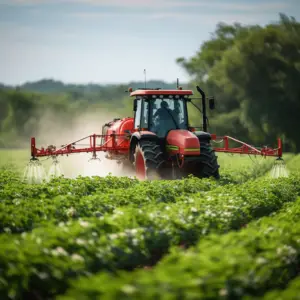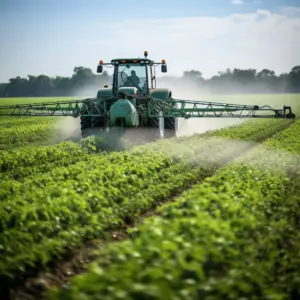Glyphosate Application Timing, Perhaps the most common way to deal with troublesome weeds and unwanted vegetation in your garden is to break them down with herbicides.
While Roundup is arguably the most popular brand among gardeners, Glyphosate is one of the most common herbicides used to eliminate weeds.
Glyphosate Application Timing, simple as it may sound, this method of getting rid of weeds can be a complex task, especially during the rainy season.
What if rain falls after applying herbicide? Will glyphosate hold up or it will be diluted, eradicating its effectiveness?
How long does this herbicide need before rain for it to work effectively? Well, there are quite a few things to wonder about, but making sure that timing is perfect is the crux of the matter; else, all your efforts may be wasted entirely.
So read on as we answer some of these questions.
Table of Contents
Can You Apply Roundup Products if it is Raining?

When applying herbicides, it is important to allow enough time for the product to work effectively before the rain falls.
Depending on the brand selected, herbicide application should be done 30 minutes to an hour before the rain- if not earlier- to effectively kill weeds.
In the event that it has already rained, wait for the leaves to dry out before applying or the compound may be washed away. It’s always important to consider the day’s forecast for the day before spraying irrespective of the weather conditions.
This includes checking the wind, temperature, and rain expected. Herbicides are considered effective when the leaves are dry; therefore it may be a waste of time and resources to spray right before or after a rainfall.
So, How Long Does Glyphosate Need to Be on Before Rain?
The good news is that it doesn’t take long. So if you’re pressed for time and are convinced that rain might fall soon, then rest easy and wait for a clear and favorable day.
This product would normally require half an hour to soak into the foliage. After that, even if the rain falls, you won’t have to worry as the product won’t be wiped away.
After rainfall, however, it can take a while for the leaves to dry to satisfaction. This is especially the case when the weather remains humid. Besides, the windy conditions may cause the herbicide to spread to other vegetation you might want to keep.
So consider the windiness as well as how long it may take the rain before spraying glyphosate. Simply put, glyphosate delivers the best results when applied at least 30 minutes before the rain sets in Just avoid using it during windy days.
What’s the Best Time of the Day to Apply Glyphosate?
The best time to apply glyphosate is when weeds are actively growing and transpiring moisture. This would necessitate sunlight, meaning you may want to apply it first thing in the morning to ensure its effectiveness throughout the day.
In simple terms, you should apply it in the morning on days when you expect more sunlight and warmth. But in the event of rainy seasons, then the stated 30-minutes window applies.
You’re advised not to apply glyphosate at night because even without rain, the herbicide would be crippled easily during this time and it won’t be effective at all.
Those who experience dew on the ground during the mornings might want to wait until most of the moisture dries up. You may also need to reapply the product to parts you have treated before, especially in dewy sections that have received over 5-6 hours of rain.
Consider the Temperature
There’s obviously more to think about other than a downpour. You need to also consider the temperature. For best results, it’s recommended to apply glyphosate when the temperature is about 60-75 degrees F throughout the day.
Lower temperatures cause slow vegetation growth, which in turn, results in slower herbicide uptake and translocation, thereby subsiding the efficacy while prolonging the necessary rainfast period. Avoid applying glyphosate during days where the temperature is lower than 40 degrees F.
How Does Glyphosate Work

First, glyphosate is a non-selective systemic herbicide used to eliminate unwanted vegetation by soaking through its foliage. That means it has to penetrate the leaf surface to sit. It does the job in weed control.
Although the absorption would take place quickly, raining after application might dilute and wash off the herbicide before it can reach the foliage.
The weed’s vascular system would deliver the herbicide to all of its parts including the roots, breaking it down within 24 hours or so. It’s not intended to soak into the roots and to the soil; therefore it will need to make contact with leaves for it to be effective.
This explains why glyphosate works great when used on dry foliage. Other than that, the herbicide will get combined with the water droplets and would definitely be washed off, getting into the soil, instead of in the leaves. This, again, hinders its effectiveness.
Note that the diluted mixture is only 2% glyphosate, which is well enough to kill off unwanted plants. Further dilution, however, would make it lower potency.
The Final Word
All things considered, glyphosate is effective in killing weeds and unwanted vegetation- but that holds true only if you apply it correctly. You’re advised not to apply it during rainy days to prevent it from losing potency.
Glyphosate Application Timing, But in case you don’t have a choice, you can apply it at least 30 minutes before the rain is expected to fall, and when the grounds are short of dew or moisture.
We hope that you grasped a lot from this quick guide, and you understand how to utilize glyphosate properly. For those planning to apply glyphosate during the rainy season, bear in mind these tips and make sure you allocate enough time for the product to work before the rain sets in.


